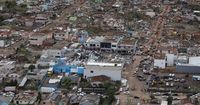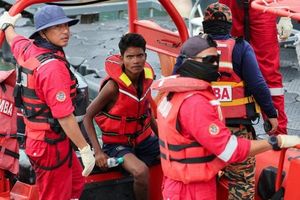When the skies darkened over Rio Bonito do Iguaçu on November 7, 2025, few could have imagined the devastation that would unfold in less than a minute. An intense tornado, rated as an F3 on the Fujita scale, tore through this small municipality in Paraná, northern Brazil, leaving a trail of destruction that the state’s governor would soon call an “unprecedented catastrophe in the history” of Paraná, as reported by Amandala.
The numbers alone are staggering. According to official reports cited by the International Organization for Migration (IOM), seven people lost their lives—three men aged 49, 57, and 83; two women aged 47 and 14 in Rio Bonito do Iguaçu; and a 53-year-old man in the neighboring city of Guarapuava. Another person remains missing. More than 800 people were injured, and the tornado cut power to around 2,000 residents. Hundreds of families were left displaced or without homes, and the authorities fear the death toll may still rise as rescue workers continue to receive information from the community.
Rio Bonito do Iguaçu, a township of about 14,000 people located nearly 400 kilometers from Curitiba, the state capital, was hit hardest. The tornado’s 155 mph (250 km/h) winds ripped roofs off buildings, flattened homes, and reduced much of the urban landscape to rubble. According to Amandala and IOM, approximately 90 percent of homes and commercial buildings in the township were affected. Schools, health facilities, and critical infrastructure—including power, sanitation, and water supply systems—were severely damaged, compounding the challenge for survivors and emergency responders alike.
Governor Ratinho Júnior, confronting the aftermath, declared a state of “public calamity,” a move that enables the government to mobilize emergency resources and request federal assistance. “It’s unlikely that any house, or even a commercial building, will remain standing. We saw silos collapsing, gas stations,” he lamented, as quoted by Amandala. The declaration echoes the widespread sense of shock and urgency gripping the region. The Brazilian weather channel Climatempo warned that the same cyclone system could generate wind gusts of over 63 mph in other states such as Rio Grande do Sul, Santa Catarina, and São Paulo, as it moved along a cold front impacting the coast of Rio de Janeiro and Espírito Santo.
In the immediate aftermath, the International Organization for Migration (IOM) sprang into action. By November 12, IOM had deployed an emergency team of 11 specialists in shelter management, health, protection, information management, and recovery to Rio Bonito do Iguaçu. The organization is working closely with the National Force of the Unified Social Assistance System (ForSUAS)—the emergency response arm of the Ministry of Social Development and Assistance, Family and Fight Against Hunger (MDS)—to provide rapid relief. Their efforts include coordinating emergency response, setting up temporary shelters, and ensuring access to social protection and benefits programs for those affected.
“The scenes in Rio Bonito do Iguaçu are difficult to witness, but the determination of its people is remarkable,” said Paolo Caputo, IOM Chief of Mission in Brazil, in a statement published by IOM. “As extreme weather events become increasingly frequent and severe, our priority is to ensure that no one is left behind. Protecting lives, restoring dignity, and helping families rebuild remain central to our mission.”
The disaster’s scale is underscored by the comparison to previous climate catastrophes in Brazil. Just over 700 kilometers away, the state of Rio Grande do Sul experienced unprecedented floods in 2024 that inundated nearly the entire state and affected more than two million people. During that crisis, IOM played a pivotal role in managing humanitarian reception centers in Porto Alegre and Canoas, providing emergency shelter and basic services for over 1,000 displaced individuals. Drawing on those lessons, IOM is once again mobilized to support affected families in Paraná, aiming for a recovery that upholds human rights, strengthens resilience, and fosters inclusion.
The tornado’s impact extended beyond physical destruction. With power and water supplies disrupted, and hundreds of families suddenly homeless, the challenge for local and international responders has been immense. Emergency workers are still gathering information about the missing and displaced, and the true scale of the tragedy may not be known for weeks. The government’s declaration of a state of emergency—described by IOM as “one of the most severe disasters ever recorded in the region”—has enabled a rapid, coordinated response, but the road to recovery will be long and arduous.
As the world’s attention turns to climate change and its increasingly dire consequences, the timing of this disaster is especially poignant. Just days after the tornado struck, delegates from around the world—including a Belizean delegation—gathered in Belém, Brazil, for the United Nations Climate Change Conference, COP30. The conference, which began on November 10, 2025, has provided a global stage for organizations like IOM to highlight the urgent need for climate action that protects the most vulnerable. IOM’s ongoing response in Paraná is a testament to the organization’s growing role in helping communities adapt to the realities of a changing climate.
The Brazilian government, meteorological services, and humanitarian organizations have all warned the public to remain vigilant. On or before November 10, residents were urged to avoid open areas due to the risk of falling trees, downed power lines, and collapsing buildings—hazards that continue to threaten safety even after the tornado’s passage. The state meteorological service, Simepar, has been closely monitoring the situation, issuing updates and working alongside emergency responders to coordinate relief efforts.
For the people of Rio Bonito do Iguaçu, the path forward is daunting. The township’s fabric has been torn apart, with homes, businesses, and public services all but destroyed. Yet amid the rubble, stories of resilience and determination are beginning to emerge. Aid workers and local officials are working around the clock to restore basic services, provide shelter, and help families begin the difficult process of rebuilding. The IOM’s presence, backed by its global expertise and recent experience in disaster response, offers a measure of hope for those who have lost so much.
As climate-related disasters become more frequent and severe, the tragedy in Paraná stands as a stark reminder of the urgent need for global cooperation, robust emergency response, and long-term strategies for resilience. The lessons learned here will undoubtedly inform future efforts, both in Brazil and beyond, to protect lives and restore dignity in the face of nature’s fury.
In Rio Bonito do Iguaçu, recovery has only just begun, but the resolve of its people—and the support of a mobilized world—suggests that even after the storm, hope endures.




